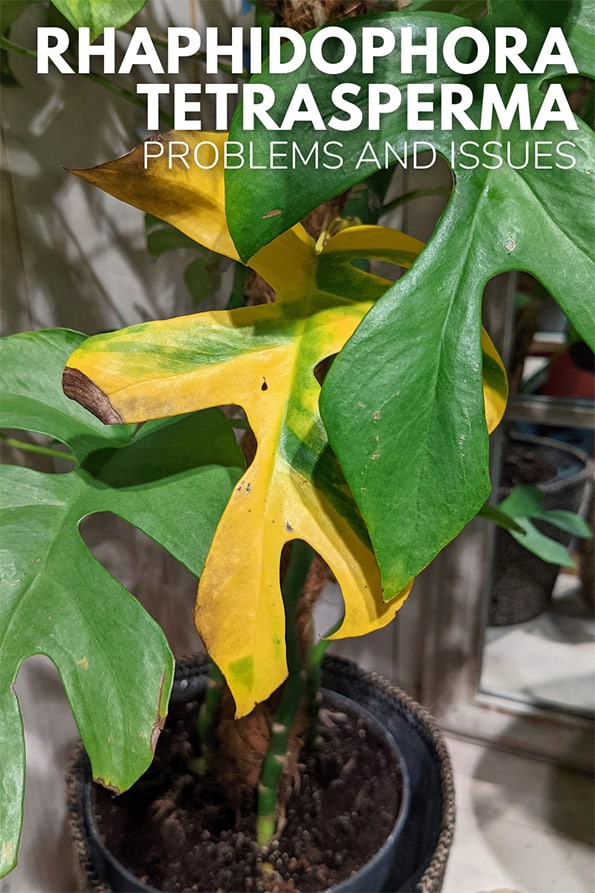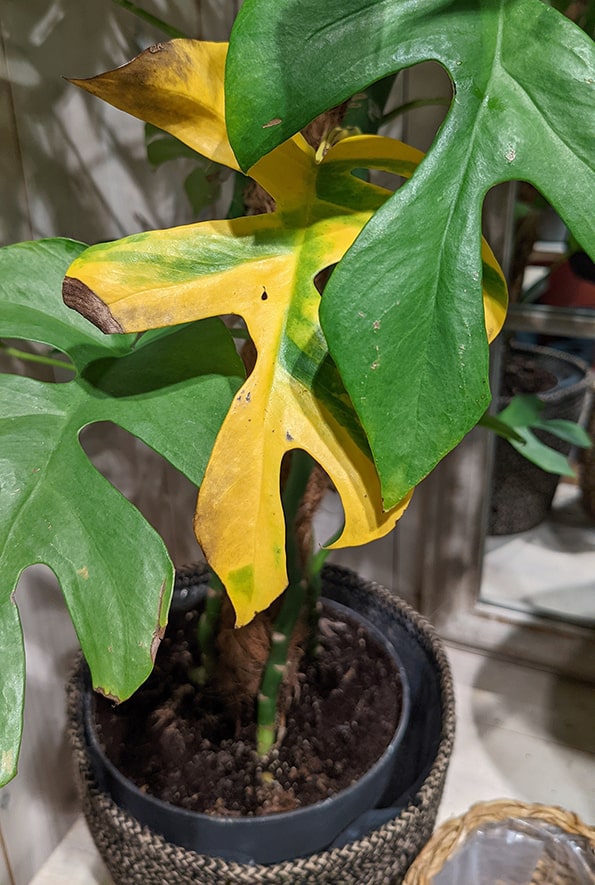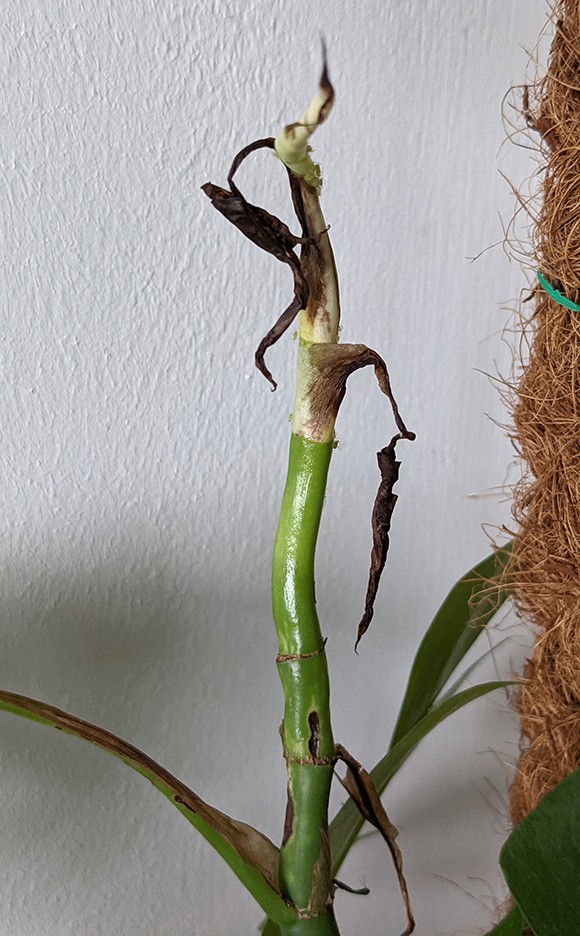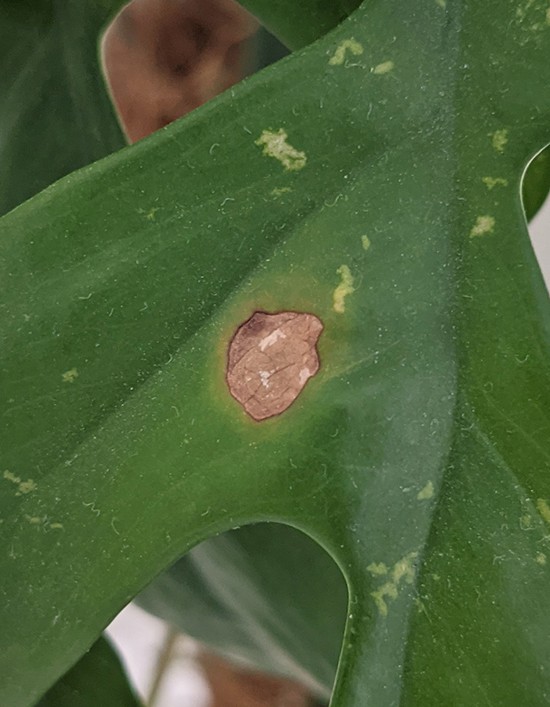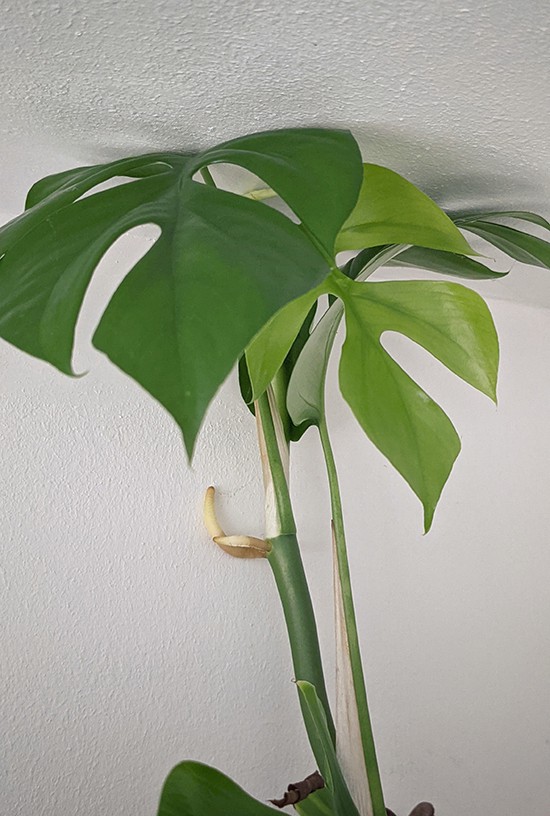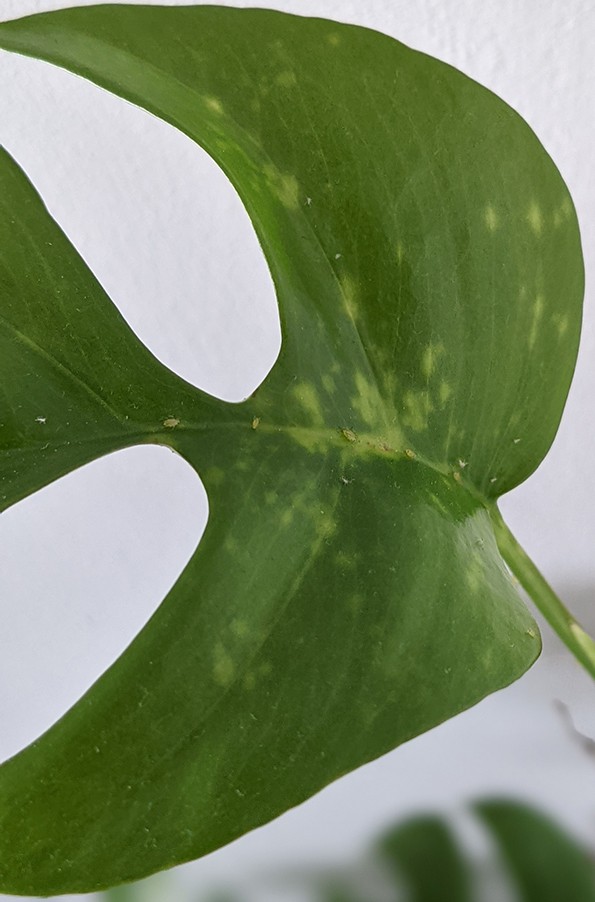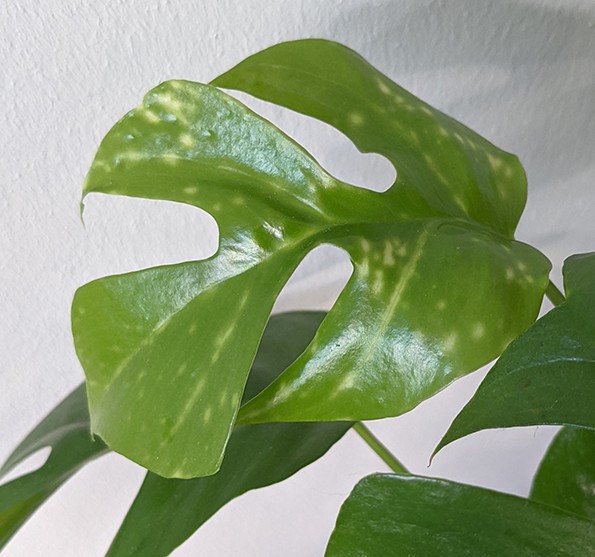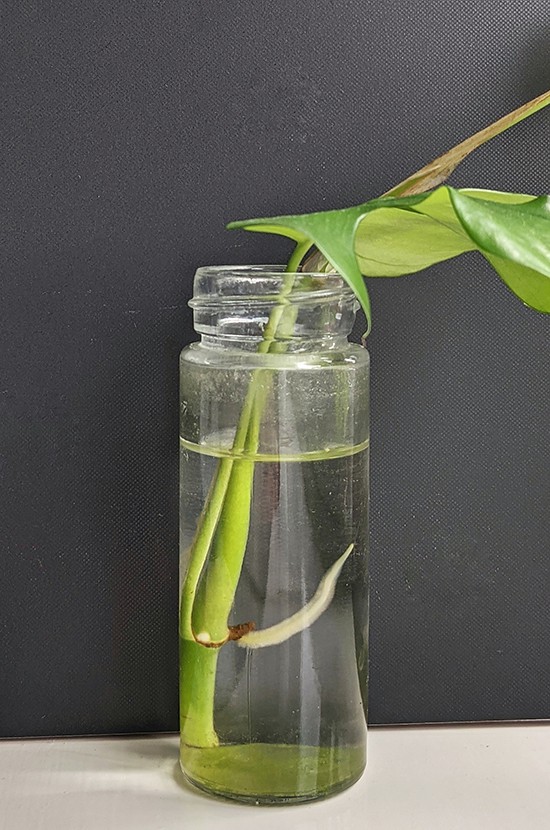By Tom Knight
Your Rhaphidophora tetrasperma Problems Solved
Problems and issues with the Rhaphidophora tetrasperma houseplant are not a common occurrence. But when they do pop up, they can ruin the look and growth of your plant.
The good news is that if you fix the cause of the issue, these plants will recover quickly. And this guide will let you identify what's gone wrong and help you solve the problem.
Rhaphidophora tetrasperma is a modern houseplant with the common names of Mini Monstera, Monstera minima and Philodendron Ginny.
If you've had this plant for a while (or if you are new to it), you should definitely spend some time reading my guide on how to care for your Mini Monstera correctly. Provide good care and most of the problems these plants can experience won't happen.
Naturally, if you've found this article, you likely already have issues that need to be solved. So let's get on with sorting them now.
Yellow Leaf Markings
Usually, Rhaphidophora tetrasperma leaves are a constant shade of green, but sometimes slight yellowing or markings will appear. It could be in small patches or splashes. If the entire leaf is going yellow, that's another issue.
Causes
Several things can cause this yellowing. You'll have to do a little investigating to see which of the following causes fits.
- Too much light.
Leaves are easily damaged by intense sunlight hitting them. Move it out of the sun's rays or provide some shielding to create indirect light instead.
- Mosaic Virus.
This has its own entry a little further on.
- Pest Pressures.
Any sap-sucking pest will cause microscopic damage to the leaves of a rhaphidophora plant, which can cause random patches of yellowing. Check the underside of the affected leaves and look out for Aphids, Spider Mites or Thrips in particular.
- Too much feed.
Giving too much fertilizer can cause fertilizer burn. But in all honestly, this is fairly rare for most houseplant owners, so the causes above are much more likely.
If you're an overfeeder, just add some slow-release organic fertilizer to the soil mix whenever you repot your plant and then make a point only to feed your plant a few times each year.
Yellow Leaves
Almost every single houseplant will create yellowing leaves from time to time. This is quite drastic appearance wise and can cause worry. It might not be anything to be concerned about though.
This Mini Monstera has yellowing leaves. There are three main reasons this could be happening.
Causes
Several things can cause this type of leaf yellowing. These are the most likely.
- Natural aging.
Mini Monstera plants do not shed their leaves often, but they will do it occasionally. The odd leaf going yellow could be natural aging, especially if it's one of the oldest leaves.
- Overwatering.
If a couple of leaves are going yellow at once, check the potting mix. If the soil is very damp or wet, it could be the early (or advanced) stages of root rot caused by overwatering.
- Draughts with Cold Temperatures.
These are tropical plants and like it warm. The cold or chilly draughts blowing by the leaves can be harmful. If you've noticed a chill near your plant, it could be time to move it somewhere warmer.
Root Rot
Every plant parent's worst nightmare. If it seems your plant is collapsing, lots of leaves going yellow, mushy stems and a general wilting, it's time to check the roots and look for possible root rot.
If the roots are mushy or black rather than firm and grey or white, you have root rot.
Causes
Root rot almost always occurs when the potting medium has been saturated with water for a prolonged period. It's more common in planters without drainage holes or using a heavy potting mix. But it can still easily happen in other circumstances for example when the plant needs less water, such as during winter.
The water pushes out all of the air, stopping effective root respiration. At the same time, harmful bacteria and fungi are taking over and damaging your plant's roots.
- Overwatering.
This is the primary cause of root rot. Essentially putting too much water into the soil and not letting it drain out of the pot or not allowing the potting mix to dry out enough before reaching for the watering can again.
- Not using a free draining potting mix.
Some potting mixes are very compact or hold a considerable amount of water. Many plants would struggle in this type of growing medium. Use "open" and free draining mixes. This helps excess water flow through and not create boggy or saturated soils.
- Avoid Overwatering and spot the early signs of it happening.
In this article, I'll teach you how to know if you're overwatering your houseplants?
Wilting and Failing Growth Shoots
I would say this is unusual, but it's clearly worrying to see. The growth tips go rotten or start to rot off and go brown.
This is more common in the winter and early Spring but it could still occur at other points during the year.
Causes
This can be tricky to accurately diagnose as a many factors could be at play. Look through the following and see if anything resonates.
- Overwatering.
Overwatering typically affects the leaves, but sometimes, it can cause rotten stems or the growing tips to rot. It's not the most common reason, but if you can rule out the following two issues, come back to this one.
- An environmental problem.
A pest infestation can weaken the plant resulting in it abandoning the main growing stem. High humidity or lots of water sitting around this area (perhaps from misting) can also cause this type of rotting. If you clear up the issue, then the growing stem should recover or be replaced with new growth.
- Damage.
If the growing tip has been hit, knocked off, or damaged somehow, it can stunt the growth. If the damage is minor, it should grow around the issue. If it's more severe damage, in time you should see a new growth shoot at a leaf node below (where the leaf and aerial root emerge from), gradually taking over and becoming the main stem.
Brown spots or brown leaf edges
Fortunately for most owners, this is pretty rare and when it does occur, it usually only appears on one or two leaves.
This section covers random brown circles on the leaf, and brown leaf edges as similar things can cause them.
Causes
Brown spots with yellow halos and brown leaf edges can be tricky to diagnose. There are a couple of things that can cause this, the trick to working out which it could be is to think about how the plant has been cared for over the last few weeks.
- Low Humidity.
This can trigger brown patches to appear. Normally on the leaf edge rather than within the leaf.
- Sun damage.
If intense sunlight falls onto the leaves, some areas can burn and go brown.
- Underwatering.
Sporadic underwater usually does no harm, but it can result in brown patches on the leaves over long periods. During Spring and Summer, try and give it regular waterings for a happy plant.
No growth
The Mini Monstera is generally a fast-growing plant over the growing seasons of Spring and Summer and it will put out a lot of growth during this period. That's almost six months every year where you can expect a new left every few weeks. So if you're not getting any new growth over this period, something is wrong.
Causes
Not growing is usually a cultural or environmental condition. It can normally be resolved pretty easily and one of the four reasons is typically the culprit.
- Not warm enough.
Tropical houseplants usually need it warm and I've found Rhaphidophora tetrasperma to be quite fussy in cooler temperatures. Daytime temperatures should always be above 16°C (61°F). This is the minimum level for growing, if you want faster growth you'll need to put it somewhere warmer than this.
- Not enough light.
They'll get by in lower light areas, but won't thrive in these places. It could be a light issue if you notice little to no growth. Move your plant out of the low light conditions and you should see improvement quickly. If you can't do this, look into getting a grow light.
- It's time to feed your plant.
Although they're not heavy feeders, they will still benefit from a high nitrogen fertilizer. Try and feed every few months as a minimum.
- Does it need repotting?
They do alright in smaller planters, but the time will come when there is no spaces for roots to grow into. When this happens growth will slow and it's time to repot your plant into a new container a little bigger than the existing one.
Loss of Fenestration / Leaf Splits
Brand new plants typically produce simple leaves with no holes or fenestrations. Once established, all leaves going forward should be fenestrated with a similar pattern from leaf to leaf.
Causes
Rhaphidophora tetrasperma plants are adaptable based on the growing environment, so any change in leaf shape will be caused by an environmental issue.
- Too little light.
This is perhaps the most common reason. When light levels are poor for a prolonged period, the leaf shape becomes more simple looking. You may also notice smaller leaves and that the stems grow for longer before producing a leaf, so things seem sparse or "leggy".
- No support.
Although they're not Monstera plants, they have a similar quirk to Monstera deliciosa plants. Both types are much less likely to produce leaf splits and fenestrations if the aerial roots are dangling and not attached to anything.
Grow them up a moss pole / totem so the aerial roots can anchor into something and the splits should quickly start to form in the new leaves going forward.
Plant Touching Ceiling
If this is a problem you're facing, I should probably start by congratulating you for growing your Rhaphidophora tetrasperma so well!
But yes, once your plant has reached the roof of its growing environment, then what?
The Mini Monstera is a vining plant from Southern Thailand that will grow to impressive heights. So at some point, those stems are going to reach your ceiling.
Causes
Good care and a happy plant are the causes of this "problem". Here are the "fixes".
- Prune the top few feet.
You can cut the stem towards the top of the plant. A new growth shoot (or two) should form from the first internode below the cutting point. Depending on how low down you prune, this will buy you a few months (maybe more) before it hits your roof again.
You can also propagate new plants from the stem sections you've cut off.
- Train it in a different direction.
Generally, the stem will always grow upwards or towards a light source. But you could train the stems to grow in a different direction, so it takes longer to reach the ceiling. Gently secure them in place with pins, or ties.
Aphids
All my Mini Monstera's, including propagated cuttings, are resistant to many pests. However, Aphids seem very attracted to them and I've had to battle them on two separate occasions.
Aphids feeding on a tetrasperma leaf.
Causes and Solutions
The causes are varied, from bringing home a new plant that's already infested or having them growing near an open window and one of these insects flying in and setting up a home.
The fact you can see them, makes treatment a bit easier.
- Treatment.
Insecticidal soap or Neem Oil can be easy fixes. But if they're not shifting, I have a full guide dealing with houseplant pests that covers Aphids, so check it out of you need help.
- Keep a close eye on your plant going forward.
Your plant could be susceptible to pests so keep a careful watch for any recurrences and treat quickly. Aphids are common carriers of Mosaic Virus as well as stunting or stopping growth. So it's in your interest to deal with them as soon as they appear.
Spider Mites
These can be prevalent insect pests for some people, especially if you live in a low humidity home. Plants are a suitable home for Spider Mites to live and feed and in time can create a large infestation.
The little insects constantly pierce the leaves and the plant heals by creating small brown dots in the process. Over time this both weakens the plant as well as ruins the look.
Solutions
Trying to find ways to deter them is the best approach as they can be tricky to get rid of entirely once they've set up home. Here are my easy tips.
Mosaic Virus
Viruses aren't common for indoor plants, but Mosaic Virus is fairly common in plants that fall in the Araceae family. Such as Monstera's and of course Rhaphidophora plants.
Some owners might think it's a pretty pattern, or they have a rare variegated plant. But often it's just the Mosaic Virus. While it won't knock down your Mini Monstera, it can be unattractive, potentially weaken the plant and if there is a subtle carrier, it can spread to other houseplants in your collection.
It may look like a nutrient deficiency, but it's actually a virus.
Causes
It's normally caused by a pest that pierces leaves and feeds off the plant's sap. Aphids are popular carriers, but any sap sucking insect could theoretically transmit it. This is how to avoid it and deal with the problem.
- Deal with pests promptly.
Inspect your plants regularly, and if you spot a pest problem, try to deal with it quickly before it can multiply and pose a bigger threat.
- Infection tends not to spread around the plant.
Although pests can move around and affect several leaves, once they've been taken care of, it's not common for Mosaic Virus to naturally progress to other leaves on the plant. This means you can remove affected leaves, and the new ones that grow should not be infected.
- No cure.
There is no cure to deal with the leaves and plants already affected. However, the virus should stop spreading once the pests have been removed. It might be worth discarding badly affected plants if the damage is very widespread.
Slow Propagation
You can propagate new plants easily through stem cuttings, but many people seem to have issues with the cuttings being slow to take or grow new roots.
They're not considered a rapid grower at this stage, but once established they will take off. This cutting has finally rooted, but it's taken over a month as the green algae growing shows.
Causes
Cuttings usually root pretty well, whether that's in soil or water, but a few things can slow it down.
- Too cold.
This is a
tropical plant so just like the main plant, cuttings need to be kept warm to grow.
- Not enough light.
If you're trying to propagate in a darker location it will take time for roots to start growing from the nodes. Keep your plant out of direct sunlight, but see if providing a little more light helps.
- The time of year.
Fall and Winter are cooler months, as well as darker generally. This time of year presents the cuttings with a double whammy of difficulty, with the cooler temperatures they dislike and the reduction in light. Try and propagate in Spring and Summer.
About the Author
![Tom Knight Tom Knight]()
Tom Knight
Over the last 20 years, Tom has successfully owned hundreds of houseplants and is always happy to share knowledge and lend his horticulture skills to those in need. He is the leading content writer for the Ourhouseplants Team.
Also on Ourhouseplants.com
Comments

